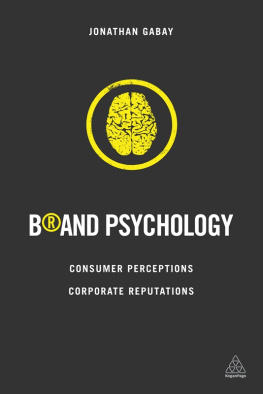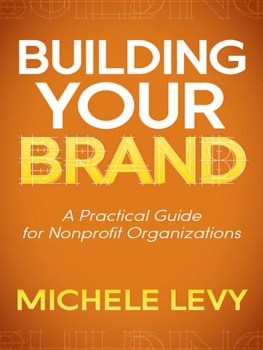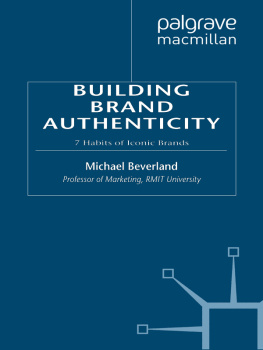Jonathan Gabay - Brand Psychology: Authenticity, Trust, Reputation
Here you can read online Jonathan Gabay - Brand Psychology: Authenticity, Trust, Reputation full text of the book (entire story) in english for free. Download pdf and epub, get meaning, cover and reviews about this ebook. year: 2015, publisher: Kogan Page, genre: Romance novel. Description of the work, (preface) as well as reviews are available. Best literature library LitArk.com created for fans of good reading and offers a wide selection of genres:
Romance novel
Science fiction
Adventure
Detective
Science
History
Home and family
Prose
Art
Politics
Computer
Non-fiction
Religion
Business
Children
Humor
Choose a favorite category and find really read worthwhile books. Enjoy immersion in the world of imagination, feel the emotions of the characters or learn something new for yourself, make an fascinating discovery.
- Book:Brand Psychology: Authenticity, Trust, Reputation
- Author:
- Publisher:Kogan Page
- Genre:
- Year:2015
- Rating:3 / 5
- Favourites:Add to favourites
- Your mark:
- 60
- 1
- 2
- 3
- 4
- 5
Brand Psychology: Authenticity, Trust, Reputation: summary, description and annotation
We offer to read an annotation, description, summary or preface (depends on what the author of the book "Brand Psychology: Authenticity, Trust, Reputation" wrote himself). If you haven't found the necessary information about the book — write in the comments, we will try to find it.
Brand Psychology: Authenticity, Trust, Reputation — read online for free the complete book (whole text) full work
Below is the text of the book, divided by pages. System saving the place of the last page read, allows you to conveniently read the book "Brand Psychology: Authenticity, Trust, Reputation" online for free, without having to search again every time where you left off. Put a bookmark, and you can go to the page where you finished reading at any time.
Font size:
Interval:
Bookmark:
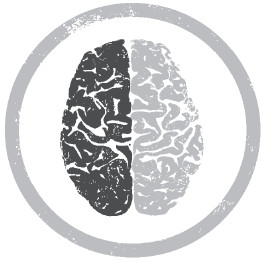
Believing Is Not Seeing.
Seeing Is Believing.

The elementary quality that makes mankind distinctive from animals is the ability to construct meaning from apparent chaos. As Carl Jung put it, In all chaos there is cosmos, in all disorder, a secret order.
From the opening chapters of evolving human history, the brain has sought to draw purpose from patterns. Whether it is the ability to recognize faces and discern friends from foes, or taking solace in a sense of great purpose by connecting shapes of gods from the polka-dotted night sky, igniting fire from stone or, of course, turning sounds and shapes into structured language.
The more deeply patterns are scrutinized, the greater the number of subsequent questions in need for reinterpretation. Probing ever deeper, mankind was able to turn astrological gods into astronomical physics, rocks into tools and questions into understanding.
The quest for meaning through asking why continues. Today, patterns are shaped in software algorithms, economics, science, sociology, and more.
When Neanderthals appeared between 300,000 and 100,000 years ago, they occupied Eurasia from the Atlantic regions of Europe, eastward to Central Asia and as far north as present-day Belgium, southward to the Mediterranean and southwest Asia. Early modern humans replaced Neanderthals around 35,000 to 24,000 years ago.
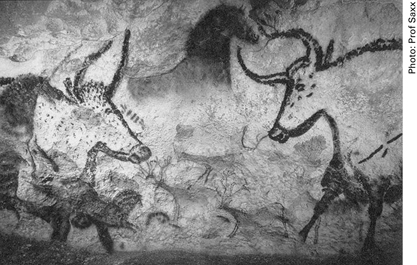
Figure 1.1 Lascaux (south-western France) Palaeolithic cave paintings
In 1856, a crew of quarrymen unearthed parts of a human skeleton in a cave at the Neander Valley near Dsseldorf, Germany. Through connecting patterns of anthropology and evidence of archaeology, it is thought that cave dwellers moved from cave to cave, or used them for special purposes such as shelter from enemies, storage and rituals.
Cave drawings and petroglyphs (stone drawings) were not simply random markings or disconnected pictures. They were structured roglyphs (stone drawings) not simply random markings or disconnected pictograms. They represented everything from cautioning rival tribes of a groups warring abilities to a communitys dominance over beasts.
Equivalently, rather than physically representing a product, a perfume brand advert or commercial often offers iconic symbols of romanticized lifestyles suggested by the fragrances.
The word brand derives from the North Germanic language, Old Norse. Residents of Scandinavia and inhabitants of their overseas settlements spoke it during the Viking Age, until 1300.
The Old Norse word brandr means to burn. It referred to the practice of using a hot iron rod to burnish cattle, slaves, timber and crockery with the markings or symbols (brands) of the owner (a practice dating back to ancient Egypt).
Indias oldest generic brand, in continuous use (since the Vedic period, 1100 BCE to 500 BCE) is the health-related herbal paste Chyawanprash. It contains a mixture of honey, ghee, sugar, sesame oil, berries and other naturally available herbs and spices.
Evidence of the earliest marketing puns as examples of protobrands can be found on wine jars at Pompeii, bearing the word Vesuvinum (a portmanteau of Vesuvius (Latin for volcano) and the Latin for wine, vinium).
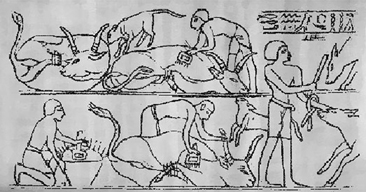
Figure 1.2 Egyptian branding 2000 BCE tomb

Figure 1.3 From brand features to brand inclusion
In the timeline of modern brand history, what started as a symbol of cattle ownership, warning would-be rustlers to keep their hands off a herd (186686), evolved into a sign of social, political or commercial inclusion inclusion branding.
Originally brands reminded and reassured consumers of quality, availability, price and service. Today much of this is left in the hands of potential customers. Products and services can be reviewed online. Expert opinions often count for more than sales promises. Accordingly brands need to provide more than simplistic mental shortcuts.
Brand reputation, creativity, persona, general allure and more besides, are conveyed through a brand mix that includes production, service management, media choice, content, public relations, logistics and information technology.
TRANSFERABLE ASSOCIATION
While logos, trademarks and slogans alone dont define branding, it is interesting to consider the etymology of the word logo. It comes from the Greek word logos which can either mean word or meaning, or is sometimes translated as rational order.
Transferable association comes into play when an image associated with one school of thought is superimposed over another. The swastika, which came to signify Nazi dominance, originally had a different meaning. The goddess Artemis is said to have had a female triangle with a swastika symbol drawn on her stomach. The Cross of Thor can also be found on ancient coins. In Hinduism the swastika represents health and prosperity. The revered Lord Ganesh wore the swastika on his right hand. Julius Caesar was the first to brand the pursuit of power and pleasure under the emblem of an eagle (both the Nazis and Americans later adopted the eagle).
Fundamentally, the concept of branding was essentially to depict ownership. The transition from This belongs to me, so hands off to This was made by me, so hands on began in the 1800s.
During the late 1890s, with the advent of railways and long-distance product distribution, branding, largely limited to the use of logos, was used to identify manufacturers. (My book Soul Traders covers this in much greater detail.)
One of the more contemporary iterations of branding is the brand hashtag. (In Spring 2014, Merriam-Webster announced it was adding the word hashtag to the dictionary.)
The use of branded hashtags is universal, from manufacturers and service brands to television shows. Its increased usage has led to a new trademark application filings for example #TEAMJESUS, #RISETOTHRIVE and #HELMETSARECOOL. (In the United States, a corporation wishing to use branded hashtags to protect its reputation and prevent consumer confusion is recommended to take federal trademark protection.)
I BUY THEREFORE I AM
Critical theory and branding
The polymath, Theodor Adorno, was a German philosopher, Marxist, musicologist and strict practitioner of critical theory. Critical theory is a social thesis primarily concerned with evaluating and changing society as a whole. Obversely, traditional theory concentrates on understanding or explaining society as it is.
Accordingly, to maximize profits, formulaic products, promoted through mass media and culture, are designed to address the lowest common denominator understood by the greatest groups of people. Following this standardization theory, you and I inhabit a media culture-driven society defined by and through the consumption of products and services. Mass media is a platform for messages adopting symbols, signifiers and signs arranged to convince consumers to buy. Once purchased, for consumers, brands become semiotic indicators of status and social belonging. Adorno likened this to apologetic music. Take pop music. It is mass-produced and promoted to act like social cement.
Next pageFont size:
Interval:
Bookmark:
Similar books «Brand Psychology: Authenticity, Trust, Reputation»
Look at similar books to Brand Psychology: Authenticity, Trust, Reputation. We have selected literature similar in name and meaning in the hope of providing readers with more options to find new, interesting, not yet read works.
Discussion, reviews of the book Brand Psychology: Authenticity, Trust, Reputation and just readers' own opinions. Leave your comments, write what you think about the work, its meaning or the main characters. Specify what exactly you liked and what you didn't like, and why you think so.

